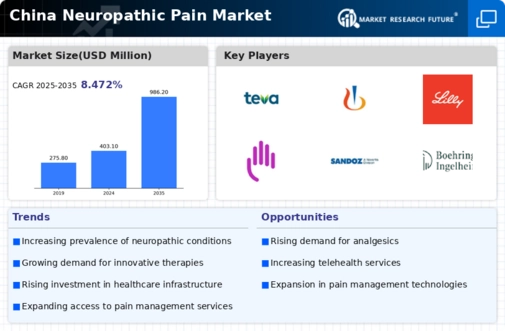Aging Population and Comorbidities
China's rapidly aging population is a significant factor influencing the neuropathic pain market. As individuals age, the likelihood of developing chronic conditions that can lead to neuropathic pain increases. Conditions such as diabetes, which affects around 11% of the adult population in China, are known to cause diabetic neuropathy. The increasing prevalence of such comorbidities necessitates effective pain management solutions, thereby driving the demand for neuropathic pain treatments. The combination of an aging demographic and the rise in chronic diseases suggests a growing market for therapies aimed at alleviating neuropathic pain.
Rising Demand for Alternative Therapies
The growing interest in alternative therapies for pain management is influencing the neuropathic pain market. In China, traditional medicine practices, such as acupuncture and herbal remedies, are gaining traction among patients seeking holistic approaches to pain relief. This trend reflects a broader shift towards integrative healthcare, where patients are increasingly open to combining conventional treatments with alternative options. The demand for such therapies is likely to drive innovation and diversification within the neuropathic pain market, as companies seek to develop products that cater to this evolving consumer preference.
Increasing Awareness of Neuropathic Pain
The growing awareness of neuropathic pain among healthcare professionals and patients is a crucial driver for the neuropathic pain market. Educational initiatives and campaigns have been implemented to inform the public about the symptoms and treatment options available. This heightened awareness is likely to lead to earlier diagnosis and treatment, which could enhance patient outcomes. In China, the prevalence of neuropathic pain is estimated to affect approximately 6-8% of the population, indicating a substantial market potential. As more individuals recognize their symptoms and seek medical advice, the demand for effective therapies is expected to rise, thereby propelling the neuropathic pain market forward.
Technological Innovations in Pain Management
Technological advancements in pain management are transforming the neuropathic pain market. Innovations such as neuromodulation devices and telemedicine platforms are becoming increasingly prevalent in China. These technologies offer new avenues for treatment and monitoring, allowing for more personalized and effective pain management strategies. For instance, the use of wearable devices that track pain levels and provide real-time feedback may enhance patient engagement and adherence to treatment plans. As these technologies continue to evolve, they are likely to play a significant role in shaping the future of the neuropathic pain market.
Government Initiatives and Healthcare Policies
Government initiatives aimed at improving healthcare access and pain management are pivotal in shaping the neuropathic pain market. In China, the government has been actively promoting policies that enhance the availability of pain management services and medications. This includes the inclusion of neuropathic pain treatments in national health insurance schemes, which could potentially lower out-of-pocket expenses for patients. Such policies are likely to increase the adoption of various treatment modalities, thereby expanding the neuropathic pain market. The commitment to improving healthcare infrastructure and access is expected to facilitate better management of neuropathic pain across the country.

























Leave a Comment